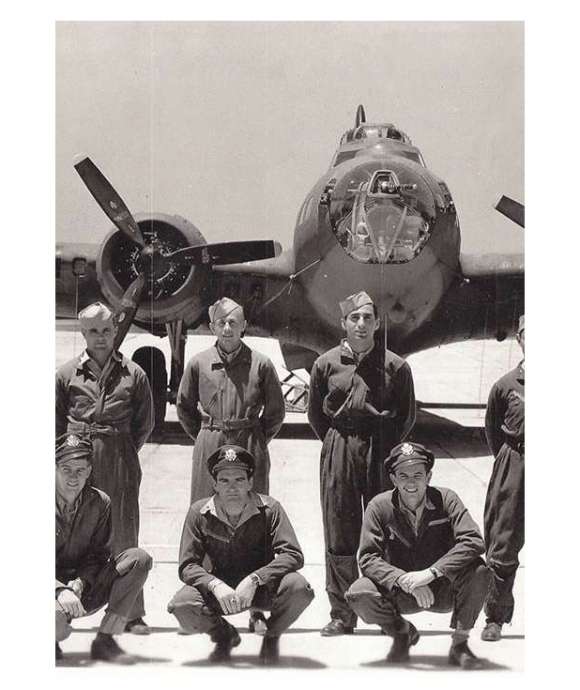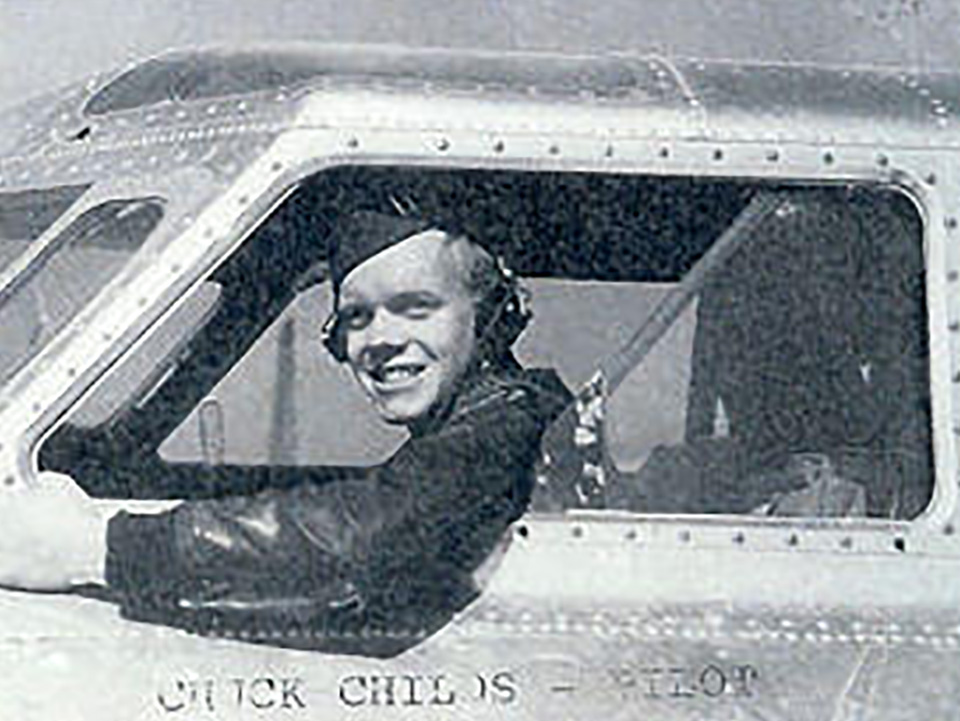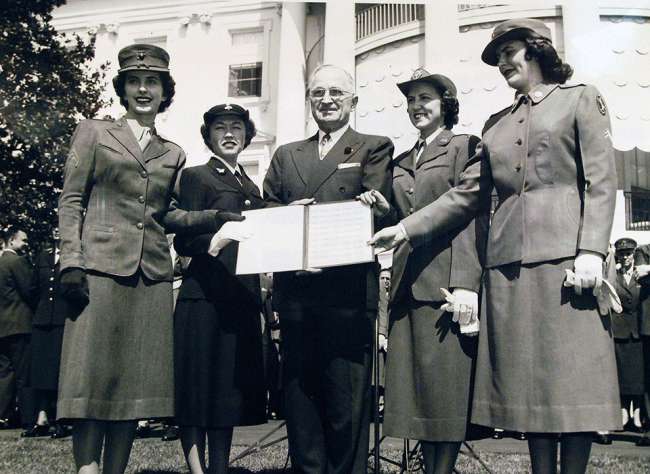The war in Europe was over. The bodies left behind were buried in cemeteries or would never be found. The live bodies, the survivors, were pulling their lives together or creating new ones back home. Chuck Childs had completed 37 missions as a B-17 pilot in Italy with the 15th Air Force. After being made lead on 32 of those missions, his love of flying wasn’t ending with the war. He returned to the states and his wife and continued to serve his country until 1961. A light machine gunner in the Army, Childs was pleasantly surprised in 1941 when he passed the tests for the aviation program. He excelled in the training but was frustrated to be made a flight instructor stationed stateside. Craving to be in combat, Childs jumped at the chance to go overseas. He made it through harrowing missions without a scratch, despite replacing crew members who were wounded and killed by flak. After the war, Childs remained with the military and flew every kind of WWII plane, moving them around the country before being stationed in DC, flying VIPs as a Douglas C-54 pilot.
As victors, the Allies inherited a great responsibility after the war. The Truman Doctrine and the Marshall Plan implemented by the United States called for their economic support of those countries resisting the tide of Communism. Moving quickly to rebuild European countries that would have some deference to Western powers, especially Germany, was a priority with the power-hungry gaze of Stalin and the Soviet Union coming from the East. Post-war Germany was divided into an Allied controlled West territory and a Soviet controlled East territory. Berlin itself, within the Soviet-controlled East territory, was divided into four sectors; Russian, American, British, and French. Trying to deny a further foothold in the control of a washed-out Europe by the Soviets meant high tensions between these world powers within Berlin. The strain on the relationship between Western and Eastern powers was shattered on June 24, 1948, when Soviet forces blockaded the city of Berlin; no transports were allowed into the zones occupied by the United States, Britain, and France.
When the Allied Forces were confronted with the reality that all roads, waterways, railways, and any means of transportation had been shut down entering West Berlin, they knew people would be without food, coal, and electricity. The only way to move supplies into Berlin would be through the three airways the Allies controlled; luckily, Tempelhof Airport was located in the American Sector. The response was almost immediate on the Allied part. Thus, the Berlin Airlift was created.
The challenge was to train pilots for the Tempelhof Airport runway. Complexities arose from the C-54 plane carrying about 70,000 pounds, landing on a short runway surrounded by tall buildings. This format was recreated as close as possible at the Great Falls Air Force Base in Montana. Chuck Childs was with one of the first groups to train this course; in his oral history interview he recalled having to almost slam the plane into the runway after diving down to allow enough space to brake. When asked why he was involved with the Berlin Airlift, Childs stated, “What they needed was C-54 pilots, good C-54 pilots…my name came up!” After training for a few weeks, Chuck Childs was headed to Germany.
Born in Salt Lake City, Utah, Gail Halvorsen flew during World War II and was stationed in Mobile, Alabama, flying foreign transports post-war. His best friend in Mobile was called up for an assignment in Germany; because his girlfriend wasn’t writing friendly letters, Halvorsen offered to take his place overseas in the spring of 1948. After going through training in the States, Halvorsen arrived in West Germany and found his accommodations to be in the upper loft of a barn. These barracks filled with the quick influx of pilots and personnel, literally leaving people to sleep wherever they could find room. Stationed at Wiesbaden Air Base, Childs slept in a building that had open showers and toilets with screens set up around each cot for privacy. Comfort and sleeping were not priorities during this mission. The pilots flew constantly, between one to two and sometimes even three missions a day, making for 16-hour days. Planes were landing at Tempelhof every three minutes around the clock for 18 months delivering tons of food and coal. The planes weighed up to 70,000 pounds and would hit the runway hard sometimes breaking up pieces of it. The Germans would run between each plane landing and try to fix what they could. Once he landed, Childs would have about 10 to 15 minutes of rest while the groups of Germans would quickly unload the 50-pound sacks of coal. On Easter Sunday the pilots stretched themselves and landed every minute for 24 hours just to stick it to Stalin. Despite the Soviet ploys at distracting the planes through intimidation techniques with fighter planes in the area, spotlights, or their assumption that the cold and foggy winter weather would deter the mission, these airmen prevailed.
Halvorsen, who had to overlook the loss of his best buddy in the war that was shot down by the Germans; felt his disdain melt away when he delivered his first load of flour and witnessed the gratitude in those German faces. Walking around Tempelhof, Halvorsen had an interaction with Berlin children that deeply affected him. He found them gathered at the gate of the airport and offered them a couple sticks of gum; amazed as the children were overcome with joy at just the smell of the bubble gum wrapper. Right then, he informed them he would drop some candy for them on his next flight as long as they shared it! Confused, they pointed out that airplanes were passing overhead every three to five minutes. Halvorsen said, “I’ll wiggle my wings in the big airplane I’ve got! When you see the wings wiggle you’ll know that’s got the stuff!” He asked his fellow servicemen for their gum and chocolate rations and dropped little parachutes made out of handkerchiefs out of his plane the next time he flew. The action was unprecedented and done without permission. One day an officer met Halvorsen when he landed. He thought he was about to be reprimanded but instead General Tunner told him to keep it up! The General expanded the operation to boxes of candy and Gail Halvorsen was to be forever known as the “Candy Bomber.”
Lt. Gail Halvorsen, "The Candy Bomber," greets children of isolated West Berlin sometime during 1948-49 after dropping candy bars from the air on tiny parachutes. Image courtesy of the US Air Force.
These men, Chuck Childs and Gail Halvorsen, and many others flew what is known today as one of the greatest humanitarian acts of the twentieth century. Through the Berlin Airlift, millions of tons of supplies were dropped to save two million people from starvation. Halvorsen mentioned, “That it was a heck of a lot better to feed them than to kill them!” The pilots and their crews were often the men who had fought the bloody wars in Europe, the Pacific, and the China Burma India theater. They had seen destruction and loss up close, had bombed cities knowing civilians were being killed and suffered through what seemed like endless days. These self-same men rushed to aid a scarcely-former enemy. Even today when Chuck Childs looks back on his service of 196 flights with the Berlin Airlift, he admits, “There wasn’t a day I flew the Berlin Airlift that I wasn’t happy to do it.”

Roland Martin and His Final Flight Aboard the Iron Maiden
A snapshot of Roland Martin's course from boyhood in California to a B-17 Pilot stationed in England, ending as a POW in Germany.
Hannah Dailey
Hannah Dailey has been an Oral Historian at The National WWII Museum since 2015 and has conducted more than 550 oral history interviews to date, several of which are showcased in our permanent galleries.
Cite this article:
MLA Citation:
APA Citation:
Chicago Style Citation:




![Max Fuchs, New York City cantor, sings as Rabbi Sydney [sic] Lefkowitz, Richmond, VA, conducts the first Jewish services from Germany.](/sites/default/files/styles/max_650x650/public/2025-10/image1.jpg)





